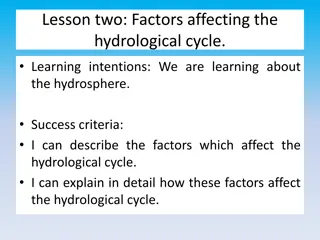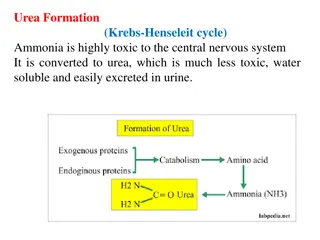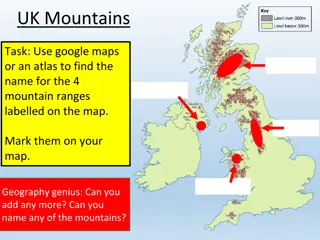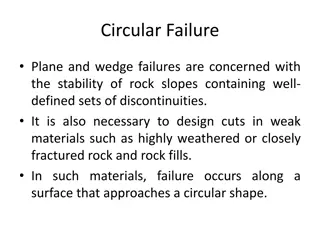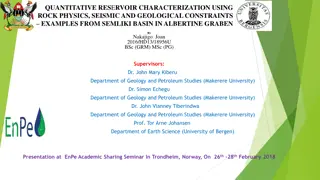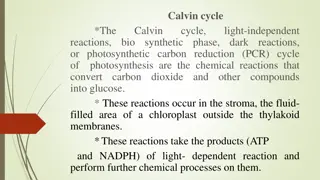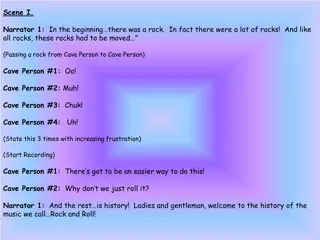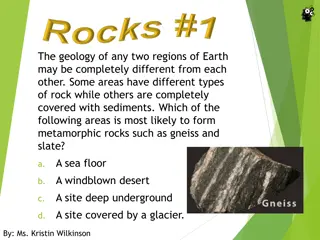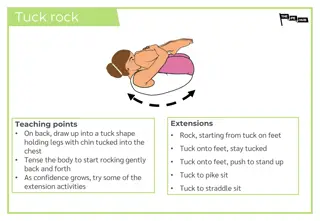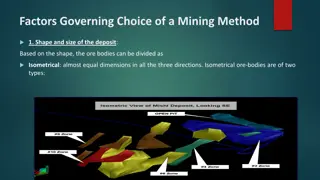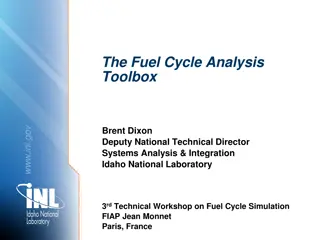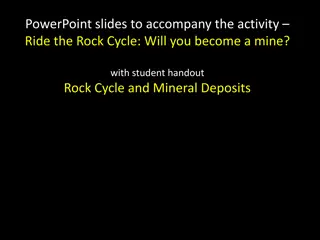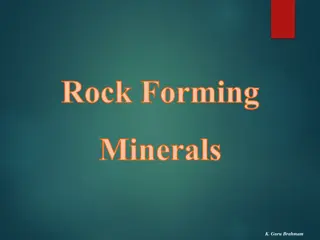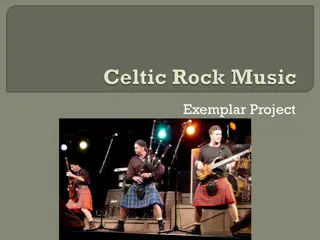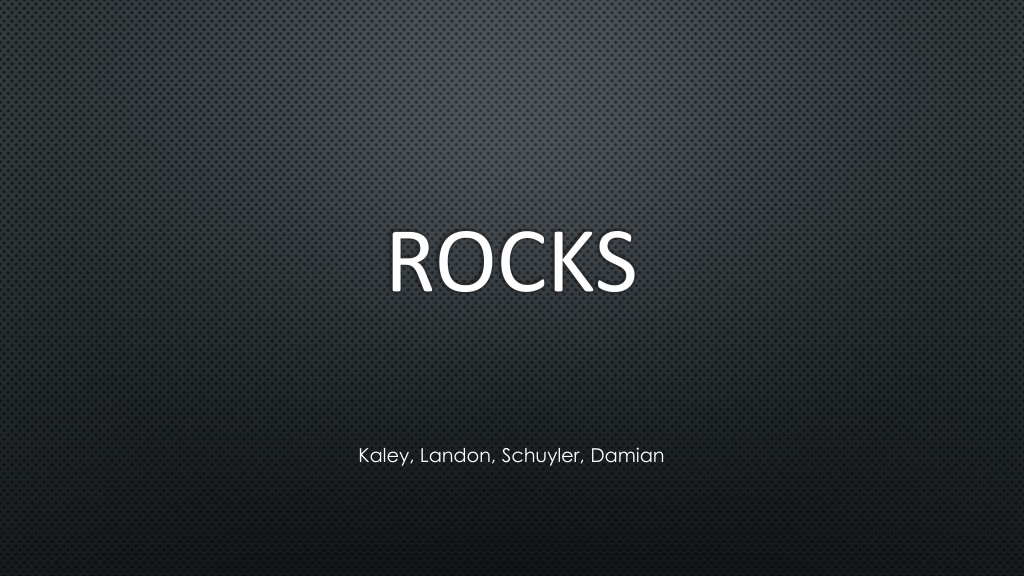
Exploring Rocks and the Rock Cycle Process
Discover the fascinating world of rocks through an exploration of different rock types such as igneous, metamorphic, and sedimentary. Learn about the rock cycle, which illustrates how rocks undergo constant change through processes like heat, pressure, and weathering. Dive into the formation of igneous rocks, their structures, textures, and compositions. Explore the origin of sedimentary rocks and how they are formed from compressed deposits. Gain insights into the classifications and characteristics of sedimentary formations.
Download Presentation

Please find below an Image/Link to download the presentation.
The content on the website is provided AS IS for your information and personal use only. It may not be sold, licensed, or shared on other websites without obtaining consent from the author. If you encounter any issues during the download, it is possible that the publisher has removed the file from their server.
You are allowed to download the files provided on this website for personal or commercial use, subject to the condition that they are used lawfully. All files are the property of their respective owners.
The content on the website is provided AS IS for your information and personal use only. It may not be sold, licensed, or shared on other websites without obtaining consent from the author.
E N D
Presentation Transcript
ROCKS Kaley, Landon, Schuyler, Damian
ROCK CYCLE The rock cycle is a process of change that is undergone by the three rock types; igneous, metamorphic and sedimentary. Sedimentary and metamorphic rock transform into an igneous rock if there is enough heat Igneous and metamorphic rocks transform into sedimentary through pressure and weathering Sedimentary and igneous rocks change to metamorphic rock through heat and pressure Weathering: change in the physical form or chemical form of rock materials exposed at the earth s surface through wing, water, glacier, gravity
IGNEOUS IGNEOUS ROCK FORMS WHEN MAGMA OR LAVA COOLS AND HARDENS. THERE ARE TWO GROUPS OF IGNEOUS ROCKS, INTRUSIVE AND EXTRUSIVE EXAMPLES OF IGNEOUS ROCKS: OBSIDIAN, GRANITE, PUMICE
IGNEOUS STRUCTURES INTRUSIONS ARE UNDERGROUND MASSES OF ROCK EXAMPLES: BATHOLITHS LARGEST, STOCK SMALLER INTRUSION, LACCOLITH LAKE OF ROCK , SILL MAGMA THAT HARDENS PARALLEL, DIKE MAGMA THAT HARDENS VERTICALLY EXTRUSIONS ARE MASSES OF ROCK ABOVE GROUND EXAMPLES: VOLCANIC NECK MAGMA HARDENS IN VENT, LAVA PLATEAU LAVA FLOWS OUT OF HORIZONTAL SEEM
IGNEOUS TEXTURE INTRUSIVE FORMS WHEN MAGMA COOLS AND HARDENS SLOWLY AND DEEP UNDERGROUND; LARGE CRYSTALS FORM EXTRUSIVE FORMS WHEN LAVA COOLS RAPIDLY ON THE EARTH S SURFACE; SMALL CRYSTALS FORM PORPHYRITIC FORMS WHEN MAGMA COOLS SLOWLY AT FIRST, BUT MORE RAPIDLY AT THE EARTH S SURFACE; LARGE & SMALL CRYSTALS ARE FORMED
IGNEOUS COMPOSITION FELSIC FORMS WHEN MAGMA THAT IS HIGH IN SILICA COOLS DOWN. MAFIC FORMS WHEN MAGMA THAT IS LOW IN SILICA BUT RICH IN IRON AND MAGNESIUM COOL DOWN. INTERMEDIATE HAS MEDIUM SILICA AND MEDIUM DENSITY
SEDIMENTARY Sedimentary rock forms when sediment deposits harden after being compressed and cemented together. Example: sandstone
SEDIMENTARY FORMATION CLASTIC SEDIMENTARY FORMS WHEN SEDIMENTS BECOME COMPACTED AND CEMENTED INTO SOLID ROCK. THEY ARE CLASSIFIED BY THE SIZE OF SEDIMENTS THEY CONTAIN CHEMICAL SEDIMENTARY FORMS FROM MINERALS THAT PRECIPITATE FROM WATER ORGANIC SEDIMENTARY FORMS FROM THE REMAINS OF ORGANISMS
SEDIMENTARY FEATURES STRATIFICATION IS LAYERING DUE TO CHANGE IN SEDIMENT TYPE RIPPLE MARKS FORM WHEN WIND OR WATER GOES OVER SAND MUD CRACKS ARE A RESULT OF A DRIED-UP LAKE BED FOSSILS ARE REMAINS OR TRACES OF ANCIENT ORGANISMS CONCRETION ARE ROCKS WITH LUMPS, LUMP IS A DIFFERENT COMPOSITION FROM THE ROCK
METAMORPHIC METAMORPHIC ROCK FORMS WHEN ANY OTHER ROCK HAS ENOUGH HEAT OR PRESSURE TO CHANGE IT EXAMPLES: SCHIST, GNEISS
METAMORPHIC FORMATION CONTACT METAMORPHISM OCCURS WHEN ROCKS NEAR THE MAGMA ARE METAMORPHOSED BY HEAT REGIONAL METAMORPHISM OCCURS DEEP UNDERGROUND OR NEAR LAKE BOUNDARIES; MOST COMMON TYPE OF METAMORPHISM
METAMORPHIC CLASSIFICATION FOLIATED FORMS WHEN CRYSTALS ALIGN IN A PARALLEL LAYERS; THEY CAN FORM FROM PRESSURE OR DENSITY EXAMPLES: (PRESSURE) SLATE AND MICA, (DENSITY) GNEISS NONFOLIATED FORMS WHEN THERE ARE NO CRYSTAL BANDS EXAMPLES: MARBLE, QUARTZITE



